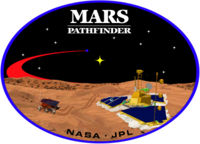Mars Pathfinder
Overview
This NASA mission was launched on a Delta II rocket on December 4, 1996. The Mars Pathfinder mission was used to demonstrate that NASA could send an exploratory mission to Mars for 1/15th of the cost of the Viking budget in the 1970's. The mission was developed at a cost of under $150 million in 3 years.
One of the major mission objectives was to deliver a microrover safely to the surface in order to study the surface composition. The microrover onboard was known as Sojourner.
The Mars Pathfinder Mission lasted from December 1996 to March 1998. It greatly surpassed its expectations by returning 2.3 billion bits of information, including over 17,000 images. pathfinder carried out more than 15 chemical analyses of rocks and soil, besides collecting data on the weather. Information learned through the mission suggest that, in its past, Mars was warm and wet, with liquid water on its surface and a thicker atmosphere. Depletion of the spacecraft's battery along with a drop in the spacecraft's operating temperature were believed to be why we lost communications with Pathfinder in October 1997. The mission far surpassed its expected 30-day lifetime.[1]

External Links
- Mars Pathfinder web site - Main entry, links to:







